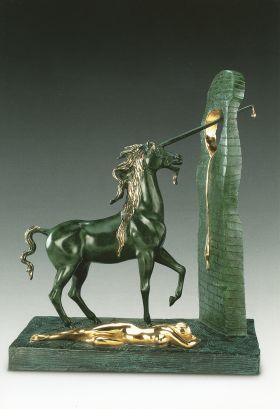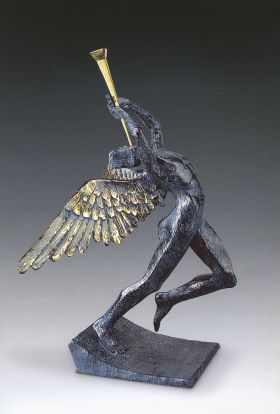CONTACT US FOR MORE INFORMATION REGARDING AVAILABILITY AND PRICING.
Dalí’s lustfully intertwines the modern and the classic in
this magnificent sculpture.
The Cubist Angel
(1983) channels the formal language of cubism, yet she stands on a pedestal - a
feature remnant of the art of antiquity.
The shining silkiness elucidated by the sculpture’s golden
finish marks Dali’s fascination with the winged messengers of God. The work’s
vibrancy is symbolic of the elegant strength of angels.
Dalí’s statement that 'nothing is more stimulating than the
idea of an angel’, emphasises his obsession with their beauty and heavenly
power.
This beautiful ode to stand figure sculptures, set in bronze
with black and gold patina, echoes themes present in The Surrealist Angel (1984).
This piece is...
-
Numbered and signed
-
Limited edition of 1500 and
35 EA.
- Made In Switzerland
- Signed by the artist on the Back Bottom Right.
Salvador Domingo Felipe Jacinto Dalí i Domènech, 1st Marquess of Dalí de Púbol (b.11 May 1904 – 23 January 1989) was a Spanish surrealist artist renowned for his technical skill, precise draftsmanship and the striking and bizarre images in his work.
Born in Figueres, Catalonia, Dalí received his formal education in fine arts at Madrid. Influenced by Impressionism and the Renaissance masters from a young age, he became increasingly attracted to Cubism and avant-garde movements.[2] He moved closer to Surrealism in the late 1920s and joined the Surrealist group in 1929, soon becoming one of its leading exponents. His best-known work, The Persistence of Memory, was completed in August 1931, and is one of the most famous Surrealist paintings. Dalí lived in France throughout the Spanish Civil War (1936 to 1939) before leaving for the United States in 1940 where he achieved commercial success. He returned to Spain in 1948 where he announced his return to the Catholic faith and developed his "nuclear mysticism" style, based on his interest in classicism, mysticism and recent scientific developments.[3]
Dalí's artistic repertoire included painting, graphic arts, film, sculpture, design and photography, at times in collaboration with other artists. He also wrote fiction, poetry, autobiography, essays and criticism. Major themes in his work include dreams, the subconscious, sexuality, religion, science and his closest personal relationships. To the dismay of those who held his work in high regard, and to the irritation of his critics, his eccentric and ostentatious public behavior often drew more attention than his artwork.[4][5] His public support for the Francoist regime, his commercial activities and the quality and authenticity of some of his late works have also been controversial.[6] His life and work were an important influence on other Surrealists, pop art and contemporary artists such as Jeff Koons and Damien Hirst.[7][8]
There are two major museums devoted to Salvador Dalí's work: the Dalí Theatre-Museum in Figueres, Spain, and the Salvador Dalí Museum in St. Petersburg, Florida.
(From Wikipedia)

 0 - $0
0 - $0












